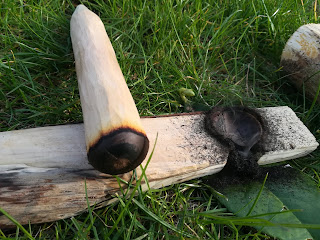So while she went off for that, I knew there was a pretty good Alder carr in the park and thought I'd check it out to see if I could get some dead, dry and standing wood.
When I had a good look about I could see there were actually quite a few Alder coppices - so finding wood in the right condition and shape was not too difficult. Unfortunately I neglected to take any ID photos, so here's something from Google to prove I actually know what indicators this tree has at this time of year.
I usually like to carve the spindle and hearth on site, since if there are problems I can search for more wood, but in this instance I was pushed for time, so I selected several pieces hoping I would have a workable set.
When I got home I carved the set below:
I was slightly concerned about a bit of punkiness on the hearth which meant it was not as wide as I would have hoped, but I reckoned I was good. I burnt in the set using the same bearing block and bow I had from the previous post.
As you can see, the bowl is a little too close to the far edge. I'm right handed so that edge is pointing away from me. I thought for a second about carving the notch on that side, but decided against it as when I push the bow I thought that would potentially push the spindle out. Instead I just ensured I had a nice upright position on the spindle, burning directly down into the hearth.
At this point I took the dog for a walk - this forced me to take 45 mins rest. I wanted to give myself the best chance of success.
First attempt looked pretty good - smoke, ash and almost an ember. A quick stretch, a drink of water and then attempt two. This time I got a big fat ember and the set worked a dream.
Conclusion: Alder is a winner when it comes to bow drill. Easily as good as Willow. I have now added two new woods to my repertoire - awesome.














